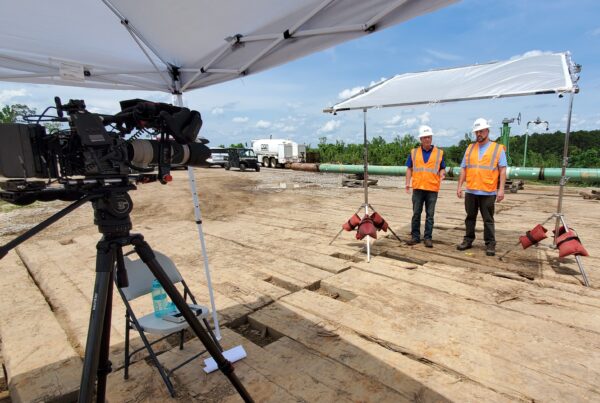Introduction to Safety Media Production
Welcome to the Media Production Guide for Safety Professionals. This comprehensive guide is designed specifically for Safety Directors, Managers, and other safety professionals who are looking to leverage the power of media to enhance their safety training and communication efforts.
The purpose of this guide is to provide you with a clear understanding of media production and its crucial role in effectively conveying safety protocols and procedures. Whether you’re considering creating safety videos, audio content, photographs, or graphics, this guide will equip you with the knowledge and insights needed to plan, create, and distribute impactful safety media content.
By integrating media into your safety initiatives, you can improve engagement, enhance information retention, and ultimately, create a safer and more informed workplace. Let’s get started on this journey towards effective safety media production.
Understanding Media Production for Safety
Media production involves the creation of content in various forms – video, photography, and audio – that can be used to communicate, educate, and influence. In the context of safety professionals, media production is a powerful tool that can be used to effectively convey safety protocols, procedures, and guidelines.
- Video Production: Video is one of the most engaging forms of media. It combines visual and auditory elements to create a compelling narrative. For safety professionals, video can be used to demonstrate safety procedures, provide virtual tours of safety facilities, or deliver safety training modules. The dynamic nature of video allows for the demonstration of processes and procedures, making it easier for viewers to understand and remember.
- Photography: Photographs can capture moments, scenarios, or situations that can be used in safety training and communication. They can be used to highlight safe practices, demonstrate the use of safety equipment, or showcase potential safety hazards. Photographs can be powerful visual aids in safety presentations, manuals, and online platforms.
- Audio Production: Audio content, such as podcasts or audio guides, can be a valuable tool for safety professionals. They can be used to deliver safety briefings, interviews with safety experts, or discussions on safety topics. Audio content can be consumed on-the-go, making it a convenient form of media for busy professionals.
As a safety professional, understanding and leveraging media production can enhance your ability to communicate important safety information effectively. By using media, you can create engaging and memorable content that can help foster a culture of safety within your organization.
The Importance of Media in Safety Training
Media plays a pivotal role in safety training. Our media production guide for safety highlights this importance. With media, safety professionals can deliver vital information in engaging ways. This leads to improved engagement. When trainees are engaged, they retain information better. This is crucial in safety training where every detail can be life-saving. Thus, a media production guide for safety is an essential tool. It ensures that safety training is effective, memorable, and impactful.
Our Guide To Planning Your Safety Media Project
Here’s a step-by-step guide on planning a safety media project:
- Set Clear Objectives: Start by defining what you want to achieve with your safety media project. Do you want to educate employees about a new safety protocol? Or, perhaps you aim to raise awareness about potential workplace hazards? Clear objectives guide the direction of your project.
- Identify Your Target Audience: Knowing your audience is key. Are you targeting new employees, seasoned staff, or perhaps a specific department? Understanding your audience helps tailor the content to their needs, ensuring the message is relevant and engaging.
- Create a Project Timeline: A timeline keeps your project on track. It outlines when each phase of the project should be completed, from initial planning to final edits. Remember to allow time for reviews and revisions.
- Develop a Content Plan: What type of media will best convey your message? A video demonstration, a podcast, or maybe an infographic? Your content plan should outline what type of media you’ll create, the key messages to include, and how you’ll distribute it.
- Allocate Resources: Identify who will be responsible for each task and ensure they have the resources needed. This includes everything from script-writing to filming and editing.
- Review and Revise: Once your content is created, review it to ensure it meets your objectives and speaks to your audience. Don’t be afraid to revise and refine until it’s just right.
Remember, every safety media project is unique, so this guide should be adapted to fit your specific needs and circumstances.
Production of Safety Videos
Creating safety videos is a multi-step process that requires careful planning and execution. As one of the only video productions in the US that focus on safety video content, so we’re deeply familiar with this topic. Here’s a detailed media production guide for safety professionals on how to create effective safety videos:
- Scripting: Start by writing a script for your video. The script should clearly outline the safety procedures or protocols you want to demonstrate. Make sure the language is simple, clear, and easy to understand. Remember, the goal is to educate, so avoid jargon and complex terms.
- Story-boarding: Once your script is ready, create a storyboard. This is a visual representation of your script, scene by scene. It helps you plan the visuals that will accompany your script, making the filming process smoother.
- Filming: Now it’s time to bring your script and storyboard to life. Ensure you have the right equipment and a suitable location. Pay attention to lighting and sound quality, as these can significantly impact the effectiveness of your video. Remember to demonstrate safety procedures accurately and clearly.
- Editing: After filming, you’ll need to edit your footage. This involves cutting, arranging, and polishing your clips to create a cohesive video. You might also add elements like text, voice-overs, or music during this stage.
- Review: Before you distribute your video, review it carefully. Check for clarity, accuracy, and engagement. It might be helpful to get feedback from a few members of your target audience at this stage.
- Distribution: Finally, distribute your video to your intended audience. This could be through an internal company platform, email, or social media. Ensure your video is easily accessible to those who need to see it.
Key Elements of Effective Safety Videos:
- Clear Instructions: Your video should provide clear, concise instructions. Remember, the goal is to educate your audience about safety procedures.
- Visual Demonstrations: Show, don’t just tell. Visual demonstrations of safety procedures are much more effective than verbal explanations alone.
- Engagement: Keep your audience engaged. This could be through the use of storytelling, high-quality visuals, or interactive elements.
- Relevance: Ensure the content is relevant to your audience. If the information isn’t applicable to their role or work environment, they’re less likely to pay attention.
Remember, creating a safety video is not just about ticking a box. It’s about ensuring the safety of your team. So, take the time to create something that will engage, educate, and protect your audience.
Production of Safety Audio Content
Safety audio content, such as podcasts or audio guides, is being recognized as an effective medium for delivering safety information. Here’s a guide that has been designed to assist in the creation of compelling safety audio content:
- Plan: Start by planning your audio content. Decide on the topics you want to cover, the format (e.g., interview, narration, etc.), and the length of each audio piece.
- Script: Write a script for your audio content. Make sure you use clear, concise language that’s easy to understand. Even though it’s audio, you still need to avoid jargon and complex terms.
- Record: Use a good quality microphone for recording. Pay attention to the acoustics of your recording location – you want a quiet, echo-free room. Speak clearly and steadily to ensure your listeners can understand you.
- Edit: Use audio editing software to refine your recording. Remove long pauses, stutters, or background noise, and add music or sound effects if appropriate.
- Review: Listen to your audio content several times to ensure it’s clear and coherent. It can also be helpful to get feedback from a few members of your target audience.
- Distribute: Choose the right channels to distribute your audio content. This could be an internal company platform, email, or a podcast hosting site.
Key Elements of Effective Safety Audio Content:
- Clear Narration: Make sure your narration is clear and easy to understand. Keep your pace steady and articulate clearly.
- Good Sound Quality: Invest in a good quality microphone and choose your recording location carefully. Poor sound quality can make your content hard to understand.
- Engagement: The audience’s interest should be maintained by making the content interesting. Storytelling, interviews, or interactive elements like quizzes or Q&A sessions can be used.
- Relevance: The content should be relevant to the audience. If the information isn’t applicable to their role or work environment, they’re less likely to listen.
In conclusion, the goal of safety audio content is to educate and inform the audience about important safety procedures and protocols. High-quality content that the audience finds valuable and engaging should be created.
Creating Safety Photographs and Graphics
Safety photographs and graphics play a crucial role in conveying safety information in a visually appealing and easily digestible manner. They can range from detailed info-graphics to safety posters displayed around the workplace. Here’s a guide on how to create effective safety photographs and graphics:
- Identify the Purpose: The first step in creating safety photographs and graphics is to identify their purpose. Are they meant to instruct, warn, or inform? Knowing the purpose will guide the design process and help ensure the final product effectively communicates the intended message.
- Design with Clarity in Mind: Safety visuals need to be clear and easy to understand at a glance. Use simple, bold designs and avoid cluttering the image with too much information. The use of universally recognized symbols and colors can also enhance clarity.
- Use High-Quality Images: If you’re using photographs, ensure they are high-resolution and well-lit. Blurry or poorly lit images can confuse the viewer and detract from the message.
- Incorporate Concise Text: While visuals are important, sometimes text is necessary to provide additional context or instructions. Keep any accompanying text concise and easy to read. Use bullet points or numbered lists where appropriate to break up information.
- Test and Get Feedback: Once you’ve created your safety photograph or graphic, test it with a small group of employees. Their feedback can help you determine if your visual is effective and easy to understand.
Remember, the goal of safety photographs and graphics is to enhance understanding and retention of safety information. By following these steps, you can create visuals that not only catch the eye but also promote a safer workplace.
Working with a Media Production Company on Safety Content
Partnering with a media production company can significantly enhance the quality and effectiveness of your safety content. However, it’s crucial to choose the right company and know how to communicate your needs effectively. Here are some tips to help you navigate this process:
Choosing the Right Company
Start by researching potential companies. Look at their portfolio to see if their style aligns with your vision. Check reviews and testimonials to gauge their reliability and customer satisfaction. Don’t forget to consider their experience in creating safety content specifically.
Communicate Your Needs
Once you’ve chosen a company, it’s time to communicate your safety needs. Be clear about your objectives, target audience, and any specific safety protocols or procedures that need to be highlighted. The more information you provide, the better they can tailor the content to your needs.
Understand the Process
Familiarize yourself with the production process. This typically includes pre-production (planning, scripting), production (filming), and post-production (editing, distribution). Knowing what to expect at each stage can help you plan accordingly and ensure a smooth process.
Review and Provide Feedback
During the production process, the company should provide you with drafts or prototypes for review. Be sure to provide timely and specific feedback to ensure the final product meets your expectations.
Build a Long-Term Relationship
If you’re satisfied with the company’s work, consider building a long-term relationship with them. This can lead to more consistent and high-quality safety content as the company becomes more familiar with your business and safety needs.
Remember, the goal of working with a media production company is to create effective safety content that meets your business’s unique needs. By choosing the right company and maintaining open and clear communication, you can ensure a successful partnership.
If you’d like to learn more about our content production process when working with safety professionals, reach out!









